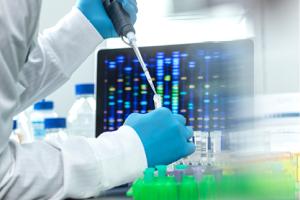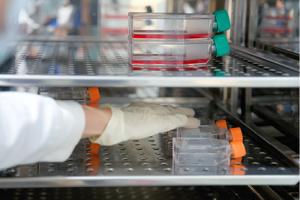Safeguarding the research of life sciences organizations

An article in our Plugged In tech and life sciences series
By Toni Mitchell, President of Technology and Life Sciences
In the development of new medical treatments, drugs, and procedures, life sciences organizations may rely on research animals to meet the FDA approval requirements. These animals play a vital role in the development of these new drugs and procedures—but with this critical work comes a unique set of risks.
Understanding the risk landscape
This research work is subject to strict and specific requirements from the FDA, USDA and other regulatory agencies to ensure the ethical treatment of these animals and the scientific integrity of the research. Additionally, with each animal can come a level of investment of time and resources that can exacerbate the impact of a loss if not properly protected.
Therefore, it is crucial that these organizations that conduct animal research secure insurance coverage with a carrier that understands and can properly valuate the work they do. A proactive risk management strategy is the first step in safeguarding both the animals and the research they support.
Establishing a foundation for protection
Proactive risk management is an essential component to safeguarding animals and research. Life sciences organizations working in this space should implement thorough processes, including:
- An emergency response plan to handle any event requiring evacuation or relocation of the animals. This plan should include controls to ensure proper handling, prevent animal escape, and identify back-up facilities where they will continue to operate. Having response procedures in place if an animal does escape from a facility is also a key part of this plan.
- Monitoring systems, such as those available through the Hanover I-on Sensor Program™, to assure that temperature, humidity and lighting are adequately maintained around the clock for the overall well-being of the animals and the integrity of the research.
- An Institutional Animal Care and Use Committee (IACUC) to review and oversee protocols for the use of research animals and ensure compliance with all regulatory standards for the appropriate housing, handling, feeding and care of these animals.
- Security and access control, including secure entry systems and surveillance to prevent unauthorized access.
Aligning coverage with valuation
When determining coverage limits for an organization that conducts animal research, there are two unique facets to consider:
- Replacement cost: How much does it cost for an animal of comparable kind or quality?
- Value change: How does the time and money already invested in research effect the animals’ worth?
Replacement costs can vary significantly and extend beyond just the animal's initial cost. That’s why organizations conducting this research must factor in the value of completed research, duration of animal use, and availability and cost of new animals. These factors are often overlooked when insured value is being determined.
Consider this example:
A research facility experienced a fire at their animal testing facility, resulting in the loss of 50 genetically modified mice. The replacement cost for each mouse was approximately $2,000, and if this was the only value considered in the facility’s insurance policy, the claim would’ve amounted to $100,000.
However, the research investment into each mouse was estimated at $50,000. Because the facility had coverage that included the value of their research investment, the carrier compensated $2,600,000 for the claim - $100,000 for the replacement of the animals and an additional $2,500,000 for the research investments made.
This example highlights the importance of working with a carrier who understands the unique risks life sciences organizations face and can offer consultation on the proper valuation that includes consideration of research and milestones to offer proper limits.
The value of industry expertise
When working with life sciences organizations, look for a carrier that offers coverage solutions specifically designed to address the risks associated with the use of research animals. A carrier like The Hanover, with deep expertise in life sciences, can provide the targeted coverage and risk management services these organizations need to successfully conduct their work safely.
Let's start a conversation today
Contact a member of our technology or life sciences teams to learn more about our coverage and services, and how we can help you tailor a solution for you and your clients.
About the author
Toni joined The Hanover in 2010 after previously holding leadership roles at One Beacon and Atlantic Mutual. As a regional executive for the Pacific Region, Toni led enterprise-wide strategies and new business development across The Hanover’s core and specialty units. In her current role, Toni delivers tailored solutions for The Hanover's technology and life sciences clients, through deep technical expertise and strong distribution partnerships.
Related resources
Safeguarding the research of life sciences organizations
An article in our Plugged In tech and life sciences series
By Toni Mitchell, President of Technology and Life Sciences
In the development of new medical treatments, drugs, and procedures, life sciences organizations may rely on research animals to meet the FDA approval requirements. These animals play a vital role in the development of these new drugs and procedures—but with this critical work comes a unique set of risks.
Understanding the risk landscape
This research work is subject to strict and specific requirements from the FDA, USDA and other regulatory agencies to ensure the ethical treatment of these animals and the scientific integrity of the research. Additionally, with each animal can come a level of investment of time and resources that can exacerbate the impact of a loss if not properly protected.
Therefore, it is crucial that these organizations that conduct animal research secure insurance coverage with a carrier that understands and can properly valuate the work they do. A proactive risk management strategy is the first step in safeguarding both the animals and the research they support.
Establishing a foundation for protection
Proactive risk management is an essential component to safeguarding animals and research. Life sciences organizations working in this space should implement thorough processes, including:
- An emergency response plan to handle any event requiring evacuation or relocation of the animals. This plan should include controls to ensure proper handling, prevent animal escape, and identify back-up facilities where they will continue to operate. Having response procedures in place if an animal does escape from a facility is also a key part of this plan.
- Monitoring systems, such as those available through the Hanover I-on Sensor Program™, to assure that temperature, humidity and lighting are adequately maintained around the clock for the overall well-being of the animals and the integrity of the research.
- An Institutional Animal Care and Use Committee (IACUC) to review and oversee protocols for the use of research animals and ensure compliance with all regulatory standards for the appropriate housing, handling, feeding and care of these animals.
- Security and access control, including secure entry systems and surveillance to prevent unauthorized access.
Aligning coverage with valuation
When determining coverage limits for an organization that conducts animal research, there are two unique facets to consider:
- Replacement cost: How much does it cost for an animal of comparable kind or quality?
- Value change: How does the time and money already invested in research effect the animals’ worth?
Replacement costs can vary significantly and extend beyond just the animal's initial cost. That’s why organizations conducting this research must factor in the value of completed research, duration of animal use, and availability and cost of new animals. These factors are often overlooked when insured value is being determined.
Consider this example:
A research facility experienced a fire at their animal testing facility, resulting in the loss of 50 genetically modified mice. The replacement cost for each mouse was approximately $2,000, and if this was the only value considered in the facility’s insurance policy, the claim would’ve amounted to $100,000.
However, the research investment into each mouse was estimated at $50,000. Because the facility had coverage that included the value of their research investment, the carrier compensated $2,600,000 for the claim - $100,000 for the replacement of the animals and an additional $2,500,000 for the research investments made.
This example highlights the importance of working with a carrier who understands the unique risks life sciences organizations face and can offer consultation on the proper valuation that includes consideration of research and milestones to offer proper limits.
The value of industry expertise
When working with life sciences organizations, look for a carrier that offers coverage solutions specifically designed to address the risks associated with the use of research animals. A carrier like The Hanover, with deep expertise in life sciences, can provide the targeted coverage and risk management services these organizations need to successfully conduct their work safely.
Let's start a conversation today
Contact a member of our technology or life sciences teams to learn more about our coverage and services, and how we can help you tailor a solution for you and your clients.
About the author
Toni joined The Hanover in 2010 after previously holding leadership roles at One Beacon and Atlantic Mutual. As a regional executive for the Pacific Region, Toni led enterprise-wide strategies and new business development across The Hanover’s core and specialty units. In her current role, Toni delivers tailored solutions for The Hanover's technology and life sciences clients, through deep technical expertise and strong distribution partnerships.
Related resources
Safeguarding the research of life sciences organizations
An article in our Plugged In tech and life sciences series
By Toni Mitchell, President of Technology and Life Sciences
In the development of new medical treatments, drugs, and procedures, life sciences organizations may rely on research animals to meet the FDA approval requirements. These animals play a vital role in the development of these new drugs and procedures—but with this critical work comes a unique set of risks.
Understanding the risk landscape
This research work is subject to strict and specific requirements from the FDA, USDA and other regulatory agencies to ensure the ethical treatment of these animals and the scientific integrity of the research. Additionally, with each animal can come a level of investment of time and resources that can exacerbate the impact of a loss if not properly protected.
Therefore, it is crucial that these organizations that conduct animal research secure insurance coverage with a carrier that understands and can properly valuate the work they do. A proactive risk management strategy is the first step in safeguarding both the animals and the research they support.
Establishing a foundation for protection
Proactive risk management is an essential component to safeguarding animals and research. Life sciences organizations working in this space should implement thorough processes, including:
- An emergency response plan to handle any event requiring evacuation or relocation of the animals. This plan should include controls to ensure proper handling, prevent animal escape, and identify back-up facilities where they will continue to operate. Having response procedures in place if an animal does escape from a facility is also a key part of this plan.
- Monitoring systems, such as those available through the Hanover I-on Sensor Program™, to assure that temperature, humidity and lighting are adequately maintained around the clock for the overall well-being of the animals and the integrity of the research.
- An Institutional Animal Care and Use Committee (IACUC) to review and oversee protocols for the use of research animals and ensure compliance with all regulatory standards for the appropriate housing, handling, feeding and care of these animals.
- Security and access control, including secure entry systems and surveillance to prevent unauthorized access.
Aligning coverage with valuation
When determining coverage limits for an organization that conducts animal research, there are two unique facets to consider:
- Replacement cost: How much does it cost for an animal of comparable kind or quality?
- Value change: How does the time and money already invested in research effect the animals’ worth?
Replacement costs can vary significantly and extend beyond just the animal's initial cost. That’s why organizations conducting this research must factor in the value of completed research, duration of animal use, and availability and cost of new animals. These factors are often overlooked when insured value is being determined.
Consider this example:
A research facility experienced a fire at their animal testing facility, resulting in the loss of 50 genetically modified mice. The replacement cost for each mouse was approximately $2,000, and if this was the only value considered in the facility’s insurance policy, the claim would’ve amounted to $100,000.
However, the research investment into each mouse was estimated at $50,000. Because the facility had coverage that included the value of their research investment, the carrier compensated $2,600,000 for the claim - $100,000 for the replacement of the animals and an additional $2,500,000 for the research investments made.
This example highlights the importance of working with a carrier who understands the unique risks life sciences organizations face and can offer consultation on the proper valuation that includes consideration of research and milestones to offer proper limits.
The value of industry expertise
When working with life sciences organizations, look for a carrier that offers coverage solutions specifically designed to address the risks associated with the use of research animals. A carrier like The Hanover, with deep expertise in life sciences, can provide the targeted coverage and risk management services these organizations need to successfully conduct their work safely.
Let's start a conversation today
Contact a member of our technology or life sciences teams to learn more about our coverage and services, and how we can help you tailor a solution for you and your clients.
About the author
Toni joined The Hanover in 2010 after previously holding leadership roles at One Beacon and Atlantic Mutual. As a regional executive for the Pacific Region, Toni led enterprise-wide strategies and new business development across The Hanover’s core and specialty units. In her current role, Toni delivers tailored solutions for The Hanover's technology and life sciences clients, through deep technical expertise and strong distribution partnerships.
Related resources
Safeguarding the research of life sciences organizations
An article in our Plugged In tech and life sciences series
By Toni Mitchell, President of Technology and Life Sciences
In the development of new medical treatments, drugs, and procedures, life sciences organizations may rely on research animals to meet the FDA approval requirements. These animals play a vital role in the development of these new drugs and procedures—but with this critical work comes a unique set of risks.
Understanding the risk landscape
This research work is subject to strict and specific requirements from the FDA, USDA and other regulatory agencies to ensure the ethical treatment of these animals and the scientific integrity of the research. Additionally, with each animal can come a level of investment of time and resources that can exacerbate the impact of a loss if not properly protected.
Therefore, it is crucial that these organizations that conduct animal research secure insurance coverage with a carrier that understands and can properly valuate the work they do. A proactive risk management strategy is the first step in safeguarding both the animals and the research they support.
Establishing a foundation for protection
Proactive risk management is an essential component to safeguarding animals and research. Life sciences organizations working in this space should implement thorough processes, including:
- An emergency response plan to handle any event requiring evacuation or relocation of the animals. This plan should include controls to ensure proper handling, prevent animal escape, and identify back-up facilities where they will continue to operate. Having response procedures in place if an animal does escape from a facility is also a key part of this plan.
- Monitoring systems, such as those available through the Hanover I-on Sensor Program™, to assure that temperature, humidity and lighting are adequately maintained around the clock for the overall well-being of the animals and the integrity of the research.
- An Institutional Animal Care and Use Committee (IACUC) to review and oversee protocols for the use of research animals and ensure compliance with all regulatory standards for the appropriate housing, handling, feeding and care of these animals.
- Security and access control, including secure entry systems and surveillance to prevent unauthorized access.
Aligning coverage with valuation
When determining coverage limits for an organization that conducts animal research, there are two unique facets to consider:
- Replacement cost: How much does it cost for an animal of comparable kind or quality?
- Value change: How does the time and money already invested in research effect the animals’ worth?
Replacement costs can vary significantly and extend beyond just the animal's initial cost. That’s why organizations conducting this research must factor in the value of completed research, duration of animal use, and availability and cost of new animals. These factors are often overlooked when insured value is being determined.
Consider this example:
A research facility experienced a fire at their animal testing facility, resulting in the loss of 50 genetically modified mice. The replacement cost for each mouse was approximately $2,000, and if this was the only value considered in the facility’s insurance policy, the claim would’ve amounted to $100,000.
However, the research investment into each mouse was estimated at $50,000. Because the facility had coverage that included the value of their research investment, the carrier compensated $2,600,000 for the claim - $100,000 for the replacement of the animals and an additional $2,500,000 for the research investments made.
This example highlights the importance of working with a carrier who understands the unique risks life sciences organizations face and can offer consultation on the proper valuation that includes consideration of research and milestones to offer proper limits.
The value of industry expertise
When working with life sciences organizations, look for a carrier that offers coverage solutions specifically designed to address the risks associated with the use of research animals. A carrier like The Hanover, with deep expertise in life sciences, can provide the targeted coverage and risk management services these organizations need to successfully conduct their work safely.
Let's start a conversation today
Contact a member of our technology or life sciences teams to learn more about our coverage and services, and how we can help you tailor a solution for you and your clients.
About the author
Toni joined The Hanover in 2010 after previously holding leadership roles at One Beacon and Atlantic Mutual. As a regional executive for the Pacific Region, Toni led enterprise-wide strategies and new business development across The Hanover’s core and specialty units. In her current role, Toni delivers tailored solutions for The Hanover's technology and life sciences clients, through deep technical expertise and strong distribution partnerships.






